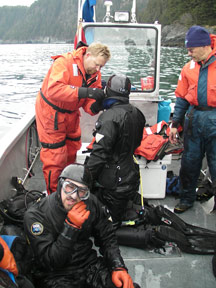Telemetry on Wild Sea Lions
 To use the Life History Transmitter tags, Researchers Dr. Jo-Ann Mellish and Dr. Horning must capture young Steller sea lions in the water with the help of a specially trained dive team (view video >>). Then, the young sea lions are brought to a special animal holding facility where qualified veterinarians surgically implant the tags inside the gut cavity while the animals are under general anesthesia. The first few implanted sea lions were kept under close observation at the facility for two months to monitor healing and general health. Now animals are released after only a brief observation period.
To use the Life History Transmitter tags, Researchers Dr. Jo-Ann Mellish and Dr. Horning must capture young Steller sea lions in the water with the help of a specially trained dive team (view video >>). Then, the young sea lions are brought to a special animal holding facility where qualified veterinarians surgically implant the tags inside the gut cavity while the animals are under general anesthesia. The first few implanted sea lions were kept under close observation at the facility for two months to monitor healing and general health. Now animals are released after only a brief observation period.
Working with live animals can be challenging and requires great care and training. Since Steller sea lions are endangered marine mammals, researchers are required to have a special permit from the National Marine Fisheries Service in order to capture and work with these animals. In addition, researchers must do their utmost to prevent harm and minimize pain and suffering. See the Surgeries page to learn more.
You can read up on some general recommendations for proper care and handling of wild pinnipeds, especially with respect to th euse of telemetry devices, in this publication of ours from 2019:
Horning M, Andrews RD, Bishop A, et al. (2019) Best practice recommendations for the use of external telemetry devices on pinnipeds. Animal Biotelemetry 7:20.